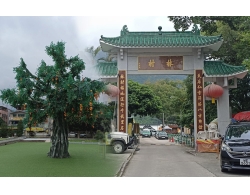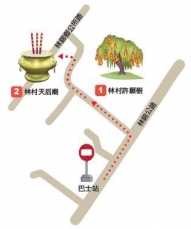Home
> Leisure Line
> Lam Tsuen

Lam Tsuen
Barrier-free Index★★★☆☆
Lam Tsuen, inhabited by villagers as early as the Southern Song Dynasty, has a history of over 700 years. Its most famed tradition is praying for wishes to come true by throwing joss papers (a parchment specifically used for offerings) into the Wishing Trees. Visitors there can also visit the Tin Hau Temple where the Wishing Trees are located and taste the famous local snack - bean curd jelly.

Enlarge map
Traffic
|
MTR
Bus |
Exit A
Low-floor bus, wheelchair waiting area |
If you start from Tai Po Market Station and get off at Uptown Plaza Exit A, turn left and enter the tunnel. There are signs along the road to the bus stop, and then you can change to Bus Route 64K.

If you take off at Tai Po Market Station Exit A, you can arrive at Tai Po Market Station Bus Terminus through the tunnel.
If you start from Tai Wo Station, still get off at Exit A, and then go to Tai Wo Plaza through the pedestrian overpass. After taking the lift to the first floor, you can change to Bus Route 64K.
 |
 |
Lam Tsuen Wishing Trees
![]()
The Lam Tsuen Wishing Trees are a famous shrine of making wishes in Hong Kong. This spot is located near the Tin Hau Temple which was built during the reign of the Qianlong Emperor in the Qing dynasty. Numerous tourists and locals coming in as families every Lunar New Year to visit the Tin Hau Temple and throw joss papers. They wrote their wishes on joss papers tied to an orange, and then threw them up into the trees. It was believed that if the papers successfully hung onto one of the tree branches, the wishes would come true. Therefore, there is a continuous stream of visitors who keep trying their luck at the trees until they finally succeed, hoping to fulfil their wishes.
However, the trees became sick and fragile due to the excessive weight of the wishes and eventually broke off. Hence, the government outlawed joss paper throwing to help the trees recover and flourish. Instead, a 25 feet high replica tree made of fiberglass was set up in place and plastic oranges tied to joss papers were provided for visitors to throw wishes and pray for luck.
| Easy-to-reach index: | |||
| Barrier-free index: | |||
| Recommendation index: |
Tour time: Approx. 30 minutes |
Short comments:
In the centre of the Lam Tsuen Wishing Square, where visitors can arrive through the iron gate on the right of the Lam Tsuen Cultural Centre, stands the replica wishing tree for visitors to throw wishes. Visitors can also hang joss papers on the wooden racks near the tree. In fact, this artificial plastic wishing tree was set up by the village office to protect the original Wishing Trees, and consequently visitors are only allowed to throw joss papers at this plastic tree.
 |
 |
In 2008, another wishing tree was transplanted from Tsang Shing to the Lam Tsuen Wishing Square. In the Square, the Lam Tsuen Wishing Festival was held in 2010 and a new wishing well for placing lotus-shaped wishing lanterns with wishing cards was constructed the following year. Next to the Lam Tsuen Wishing Square lies the Square of the Chinese Zodiac where visitors can make wishes and pray based on their own animal sign.
The original wishing tree on the right of the memorial archway at the entrance of Lam Tsuen is now a grade-two cultural relic. Surrounded by rails, it has been conversed by the government due to its sickness and the injuries caused by its broken branches in 2005. Another wishing tree was built for visitors to cast the joss papers and at the same time for the original wishing tree to recover and flourish.
 |
Address: Fong Ma Po Village, Lam Tsuen, Tai Po
Tin Hau Temple at Lam Tsuen
![]()

The Tin Hau Temple at Lam Tsuen near the Wishing Trees was built during the reign of the Qianlong Emperor in the Qing dynasty. It is a Grade II historic building with a history of over 200 years. Visitors can visit it after throwing wishes at the Wishing Trees. The temple is designed with a main palace dedicated to the Goddess of the Sea, Tin Hau, and two halls dedicated to Goddess of Mercy, Quan Yin, and God of Wealth respectively. There are also statues of gods Clairvoyant Eyes and Ears Deity alongside together with a brass incense burner filled with joss sticks, made during the reign of the Qianlong Emperor in the Qing dynasty.
| Easy-to-reach index: | |||
| Barrier-free index: | |||
| Recommendation index: |
Tour time: Approx. 30 minutes |
Short comments:
Visitors can enter the Tin Hau Temple from its right or left side, but the problem is that although there is a short staircase with only several steps on its left side, wheelchair users who wish to use the ramp on the right side have to make a long detour. Even worse, the steps at the entrance of the Tin Hau Temple are too high for wheelchair users to enter the Temple.
Hint:
Fong Ma Po Public Toilet near the Tin Hau Temple is an accessible toilet. It received the Bronze Award for the Best Public Toilets of the Year 2006 in Hong Kong.
 |
 |
Address: Fong Ma Po Village, Lam Tsuen, Tai Po
Info
If you get off at the bus stop Fong Ma Po (Lam Tsuen Wishing Tree), go across the road and turn left at Lam Tsuen Heung Kung Sho Road. Then you can see the memorial archway at the entrance of Lam Tsuen.
Tips
If you walk over the zebra crossing in front of the McDonald's on the first floor of Tai Wo Plaza, you can arrive at the 64K Bus Stop, but there is a narrow, inconvenient pedestrian way you need to pass. Therefore, it is better to turn left and walk for about two minutes first, and then walk across the road on another zebra crossing to the 64K Bus Stop.










